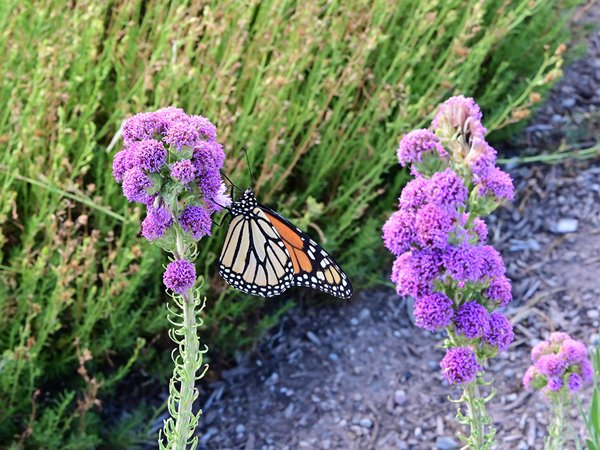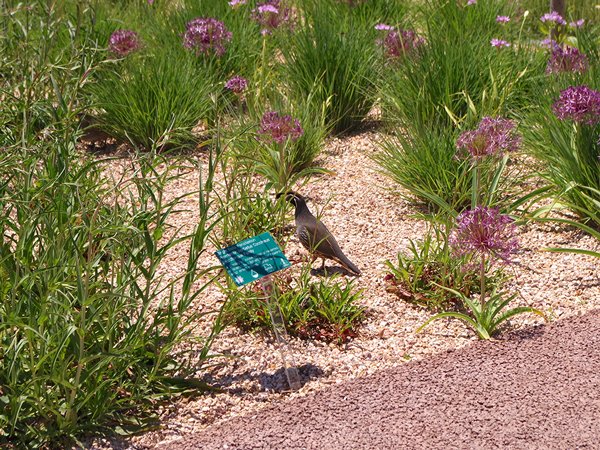Create Year-Round Interest in Your Garden
By Celeste Tholen, Assistant Horticulturist, and Susie Kohler, Administrative Assistant
Gardens are most dynamic in summer, but with attention and effort, they can thrill year-round. Highlights change, plants bloom and fade, and pollinators appear at various points of the year. In this article, we’ll explore how traditional design elements, such as color, texture, and form, create layers of interests and more ways to interact with nature.
One piece of advice before we get into design details: Get out each season and observe. The more you pay attention, the more you’ll know about what’s already there. What do you see? What do you smell? Hear? Feel? Taste? Note gardening basics like sun exposure and moisture levels, then go deeper and consider how to engage all your senses and make choices that serve your interests and those of the wildlife around you.
Incorporate Color
Color is often the first design element people think about since our eyes are drawn to it and it evokes an emotional response. Everyone approaches color differently—some people want a lot and others restrict their palette. Start noting what grabs your interest in other yards or landscapes.
Timing
Next, observe the timing of color. When is your yard most colorful and when does color fade? Some perennials, for example, look burned and browned in late summer. When your yard looks drab, look around town for vibrant blooms and foliage and note what catches your attention.
From there, add color. Flowers are often showiest, but plants are dynamic organisms that produce pigments in every part. Look at leaves—adaptations produce stunning colors like chartreuse, silver, wine, purple, and so on. The many hues of coral bells brighten shaded areas, and sparkling colors of Sedum enliven your sunniest beds. Create stunning contrast with dark grass and grass-like plants such as the dark black mondo grass (Ophiopogon planiscapus ‘Nigrescens’) or rusty Buchanan’s sedge (Carex buchananii).
Fall brings a second layer of leaf color, showing itself when the chlorophyll exits leaf cells to reveal yellow carotenoid and red anthocyanin pigments. Trees like Aesculus hippocastanum (horse chestnut) or shrubby Amelanchier utahensis (Utah serviceberry) and Rhus typhina (staghorn sumac) are stunning in the fall.
Grasses such as switchgrass (Panicum virgatum) or alkali sacaton (Sporobolus airoides) are most magnificent late in the year with striking leaf color in fall or a showy inflorescence that sticks around through winter.
Of course, evergreen plants are year-round stalwarts of color in the garden. Try to incorporate conifers like lacebark pine (Pinus bungeana) or broad-leaf evergreens like Prague viburnum (Viburnum × pragense).
Flowers
Flowers, the reproductive part of angiosperm plants, attract pollinators with their color. Consider what blooms when and how color migrates through the garden over a season. Spring-blooming trees like Princess Kay plum (Prunus nigra ‘Princess Kay’) or shrubs like weeping forsythia (Forsythia suspensa) are harbingers of warmer days. Perennial forbs achieve multi-season color but individual species often bloom only for part of the season. Companion plant them with other perennials, bulbs, or annuals that bloom at complementary times. Sedge inflorescence often appear when perennial flowers are least showy in the heat of late summer and linger into winter.
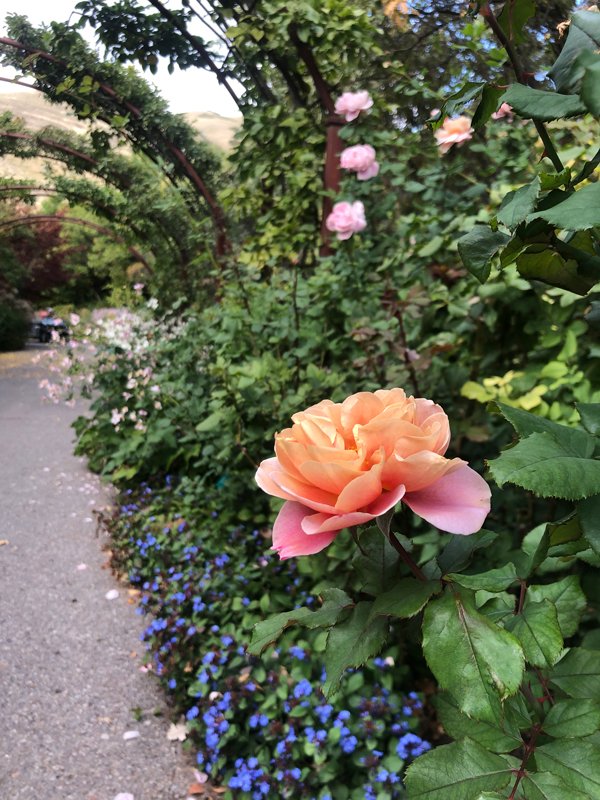
The warm tones of distant drums rose (Rosa ‘Distant Drums’) energizes the cool blues of hardy plumbago (Ceratostigma plumbaginoides). Photo: Celeste Tholen
Canadian serviceberry (Amelanchier canadensis) flowers create a frothy show in the spring, followed by glowing leaves in fall. Photos: Jason Baker
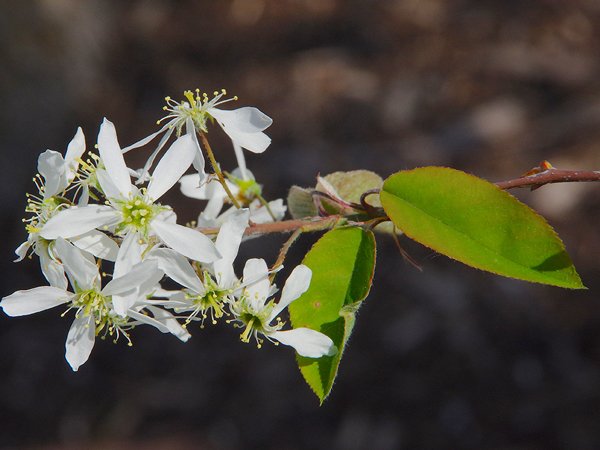
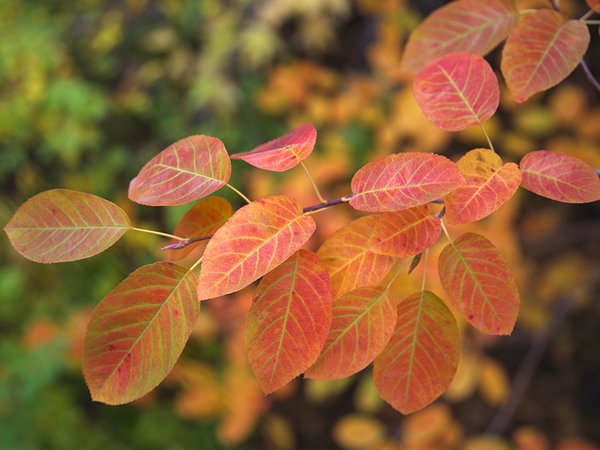
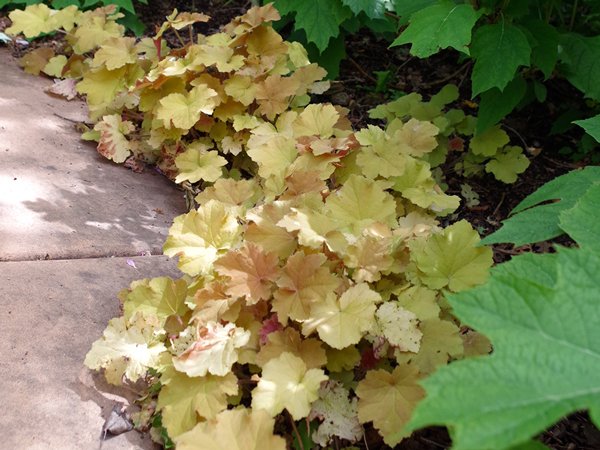
Color by Season
Break up your efforts to add color into seasonal chunks:
Spring: Nurseries tend to be best stocked then, and it’s a good time to plant. Look for colorful foliage, diverse bloom times, interesting fall color, or winter interest like bark or fruit.
Summer: Note how color changes and when your space looks bland. Head back over to the nursery to find what you’re missing.
Fall: Lean on grasses, cool-season annuals, and fall-blooming perennials. Fall is also a good time to plant spring bulbs, new perennials, and trees.
Winter: This is when evergreens and woody plants with interesting bark shine. Consider leaving sturdier perennials and ornamental grasses until spring.
The ruffled leaves of carmel coral bells (Heuchera villosa ‘Carmel’) brighten a border all spring, summer, and fall. Photo: Susie McNutt
Foliage
When leaves and flowers drop, bark provides interest, especially against a backdrop of snow. Look for plants with brightly colored, white, or dark barks like white dogwood (Cornus alba) or creamy London plane tree (Platanus x acerifolia). Peeling, mottled, shiny or otherwise-textured bark often reveals layers of color. River birch (Betula nigra), Chinese elm (Ulmus parvifolia), Tibetan cherry (Prunus serrula), and seven-son tree (Heptacodium miconioides) have stunning winter color and texture.
Fruits and Cones
Fruits and cones extend color into winter. Look for shrubs or trees with persisting fruits or cones like crabapple (Malus) hybrids, Japanese barberry (Berberis thunbergii), nannyberry viburnum (Viburnum lentago), or weeping white spruce (Picea glauca ‘Pendula’). Some also provide winter forage for birds and other wildlife.
Other Elements
Finally, pots, patio furniture, sculpture, and stones bring consistent color all year. Pick a couple of elements you love and scatter throughout the yard as focal points or complements to plantings. They can be rustic, contemporary, humorous, shiny, rough, and so on. If you leave your pots out year-round, pick materials that can handle freezing temperatures.
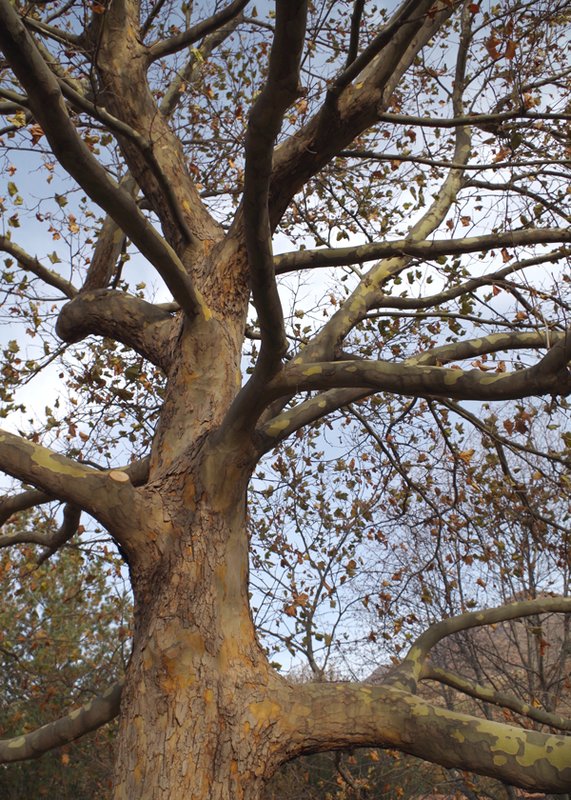
Peeling, mottled bark like that on bloodgood London plane tree (Platanus x acerifolia ‘Bloodgood’) stand out in the winter. Photo: Heidi Simper
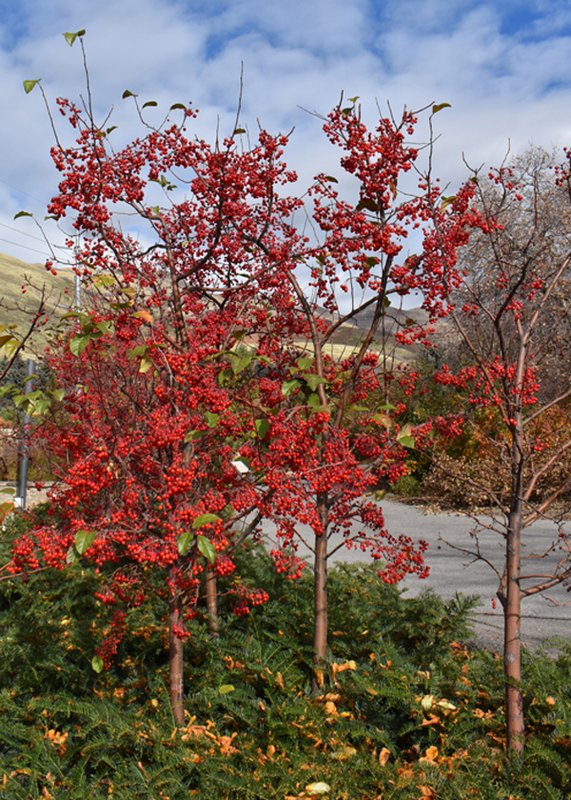
Some woody plants, like red jewel crabapple (Malus ‘Jewelcole’), produce fruit that stays on the branch through fall or winter. Photo: Heidi Simper
Consider Texture and Form
While color usually catches your eye, texture and form direct it. If you’ve been delighted by how grasses and broad-leaf perennials look together, you’ve noticed texture. Or if a weeping conifer next to a columnar deciduous tree grabbed your attention, that was contrasting form. Use form and texture to create subtle cohesion or exciting contrasts.
Texture
You can break up texture into broad categories of fine, medium, and course. Most plants are considered medium textured.
- Fine: Think grasses or other plants that catch illuminating backlight. Fine texture creates a sense of movement, particularly during a slight breeze.
- Medium: These are smaller or lacy leaves and can cast interesting shadows.
- Course: This can be larger or rugged leaves, thorns, or flowers. Course textures appear rougher.
Coarse shrub leaves, medium-textured perennials, and fine grasses come together to create texture in the Red Butte Garden Fragrance Garden. Photo: Heidi Simper
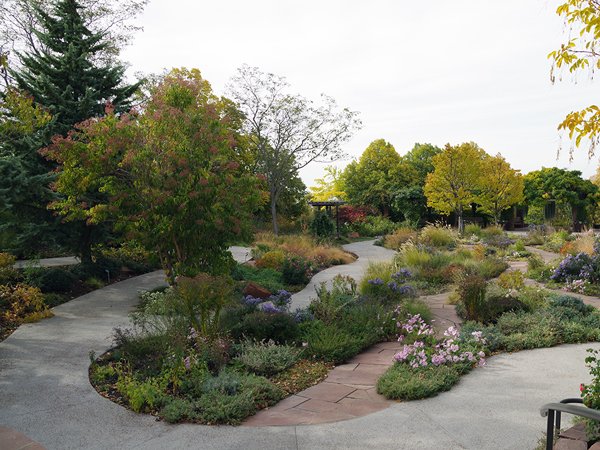
Form
Form refers to a plant’s overall habit, and as is often described as upright, mounding, creeping, weeping, or cascading. Use a variety of interesting shapes, sizes, and heights to move the eye to various points throughout the garden. For example, upright spikes of plants such as Culver’s root (Veronicastrum virginicum) contrast against mounded grasses like muhly grass (Muhlenbergia capillaris).
These two Scots pines (Pinus sylvestris ‘Hillside Creeper’ and ‘Fastiagata’) are examples of the diversity in plant form. Photos: Marita Tewes and Jason Baker
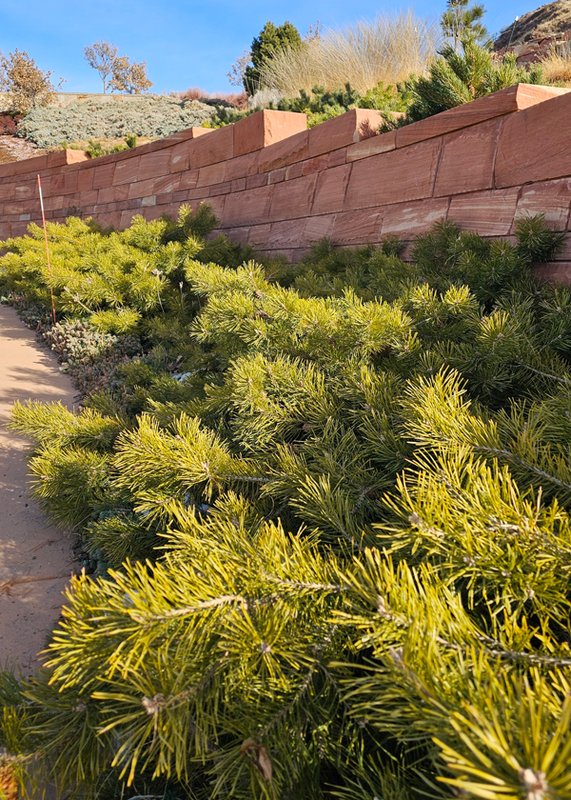
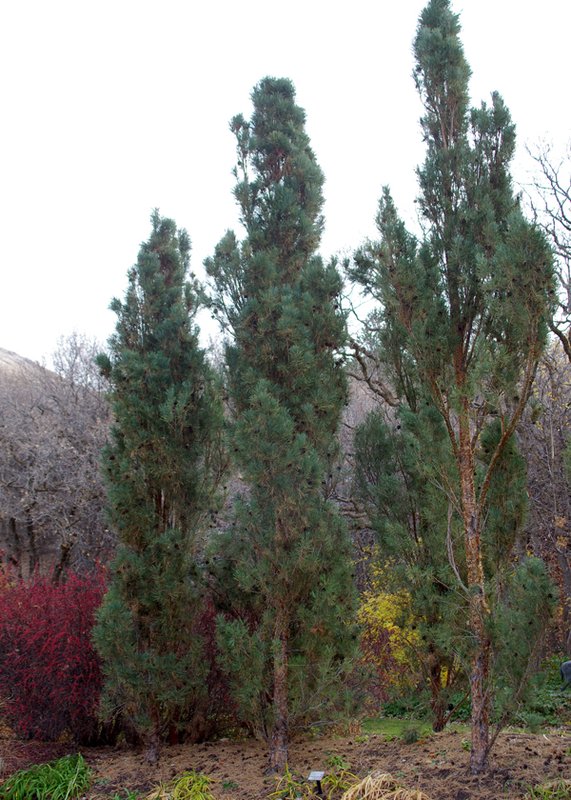
Engage the Senses
Gardens are powerful spaces of mindfulness when we can smell, taste, and touch them, and a single plant can have many uses or associations. Edible, medicinal, and fragrant plants create opportunities to connect with the natural world and enjoy a richer experience year-round.
Try interplanting borders with herbs you love to cook with or create a privacy screen using a shrub that produces yummy fruit. Plant fragrant vines or shrubs near your home’s windows or doors (be sure to give them adequate space to reach full size.
Colorful containers brighten up spaces, and incorporating edible plants among ornamentals engages the senses.
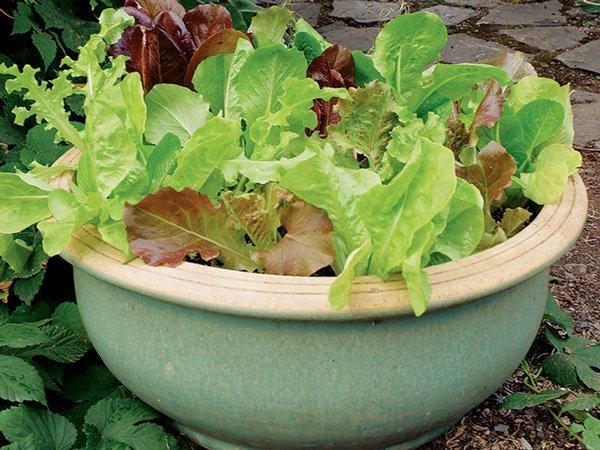
Preserve and Create Habitat
Some look at wildlife in our yards as a nuisance, but animals, insects, and bugs are critical to local ecosystems—including our gardens. Our yards can support these creatures with year-round sources of food, water, or habitat. In turn, we're rewarded with better pollination, fewer pests, and a seasonal array of fascinating fauna.
Pollinators, many of which are in steep decline due to loss of habitat, play a critical role in the natural world and agriculture. We can support them (butterflies, bees, moths, wasps, beetles, birds, and bats) by selecting plants and practicing landscaping techniques that are pollinator-friendly.
When selecting plants for pollinators, seek out those native to your region. Utah State University has a great list of plants that are important native bee nesting and forage material. The Xerces Society published a guide to plants that will attract pollinators and beneficial insects and improve the health of your garden. Utah’s pollinator program offers information on pollinator gardens, seed mixes, and grants.
Creating a pollinator habitat supports critical species like monarchs and rewards you with better pollination. Photo: Glenn Eurick
Inviting birds and other local wildlife into your landscape creates opportunities to connect with nature. Photo: Jason Baker
Reap the Rewards
A few adjustments to gardening practices will make your yard a more hospitable habitat. Wait until spring when new growth comes up to cut back perennials and grasses and leave leaf litter to overwinter, even if it’s just in a back corner where neighbors or the HOA won’t take issue. Birds will forage on seedheads and use them as a perch from predators, and fallen leaves provide habitat for overwintering insects. Planting sentinel trees, like cedar, creates perches for raptors, while shrubs with stiff, dense branches provide cover for small mammals or ground birds. Leaves, bark, the play of light, and shadows are interesting to us and useful camouflage for critters.
Gardens change through every season and feel different year to year. As gardeners, we get the privilege to observe, enjoy, and tweak as we see fit. Time spent in the garden can be relaxing or hardworking, solitary or social. Your focus can be up close and concentrated on tasks like spring pruning, or you can stand back and appreciate the vistas and long winter shadows. Whatever stage your garden is in, get out there and delight in what’s happening already!
